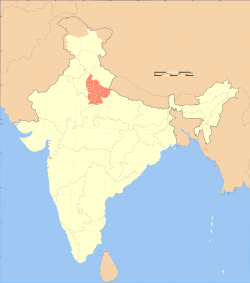
Harit Pradesh (Hindi: हरित प्रदेश, Urdu: ہرِت پردیش) is a proposed new state of India comprising the western parts of Uttar Pradesh state.[1] Braj Pradesh (ब्रज प्रदेश) and Pashchim Pradesh (पश्चिम प्रदेश) are alternative names that have been proposed, because the region incorporates the historic region of Braj and is the western (pashchim in Hindi) part of Uttar Pradesh respectively.[1][2] Braj Pradesh, however, is a term that has historically been used for parts of the proposed state's territory as well as some adjoining regions of Rajasthan state.[3] Usage of that term by authors or politicians doesn't necessarily denote support for the movement to create a separate state.
Contents[hide] |
[edit] History, support and opposition
Uttar Pradesh is a large state, and "the cultural divide between the east and the west is considerable, with the purabiyas (easterners) often being clubbed with Biharis in the perception of the westerners."[4] At the village level, some commentators have observed that Western Uttar Pradesh resembles Haryana and Rajasthan more than it does Eastern Uttar Pradesh, and the eastern region resembles Bihar more than it does Western Uttar Pradesh.[5] Also, due to the successes of the Green Revolution, Western Uttar Pradesh has experienced both economic and social development, in a fashion similar to Haryana and Punjab.[6][7][8] Eastern Uttar Pradesh, like Bihar, has not benefited to the same extent.[9][10] The resulting disparity is believed to be partially responsible for the demand for separate statehood in Western Uttar Pradesh.[11][12]
In his 1955 critique of the proposed States Reorganisation Act, Thoughts on Linguistic States, B. R. Ambedkar had advocated the division of Uttar Pradesh into three states - Eastern, Central and Western, with capitals at Meerut, Kanpur and Allahabad respectively - in order to prevent excessively large states from dominating politics at the national level.[13] The act was passed in 1956, however, keeping Uttar Pradesh intact as a single state. Later, in 1972, fourteen MLAs in the Uttar Pradesh state assembly moved an unsuccessful resolution to divide the state into three units (Braj Pradesh, Awadh Pradesh and Purbi Pradesh).[14]
[edit] Role of specific rural communities
In recent decades, Uttar Pradesh has seen the economic and political rise of the Yadav community, which has a large population and spread in Uttar Pradesh.[15] The Jats, who are a dominant agricultural community spread across Pakistan, Punjab, Haryana and Western Uttar Pradesh, have found themselves in a "politically disadvantageous position" in Western Uttar Pradesh due to this increasing influence of the Yadavs.[15] A separate Harit Pradesh would likely become a prosperous smaller state similar to Haryana and Punjab, under greater political control of local ethnic groups, such as the Jats, Tyagis, Gujjars and Muslims.[15] Yadavs would have a strong continuing presence in the area as well.[16]
The most prominent current-day advocate for the creation of the new state is Ajit Singh, the leader of the Rashtriya Lok Dal party and a Jat. Other Jat leaders, such as Om Prakash Chautala of neighboring Haryana state and the leader of the Indian National Lok Dal have also made efforts to involve themselves in the politics of creating a separate state.[17] Since the Muslim population in Western Uttar Pradesh (25%-34%, according to various sources) is higher than in Uttar Pradesh as a whole (17%), the Harit Pradesh proposal has found support from Muslim-affiliated organizations.[18][19][20][21] Of the other main political forces in Uttar Pradesh, the Bahujan Samaj Party has supported the demand in principle, the Samajwadi Party has opposed it, and the Indian National Congress and the Bharatiya Janata Party have adopted a non-committal stance.[22] From the Bahujan Samaj Party, Mayawati and DP Yadav have been vocal about their support.
Rashtriya Lok Dal alleges that "Western UP contributes to a large chunk - nearly 72% - of the state's total income. In turn, what western UP gets is not enough. Just 18% of the state's budget is spent on developing west UP. This anomaly, understandably, makes the people of this area dissatisfied".[23]
The creation of three new states in 2000 (Jharkhand from the division of Bihar, Uttarakhand from the division of Uttar Pradesh and Chhattisgarh from the division of Madhya Pradesh) gave new impetus to the demand for Harit Pradesh.[15]
[edit] Geography
The proposed state would include 22 districts in six divisions:
It shares borders with the current states of Uttarakhand, Haryana, Delhi, Rajasthan and Madhya Pradesh, as well as a brief international border with Nepal in Pilibhit district.

No comments:
Post a Comment